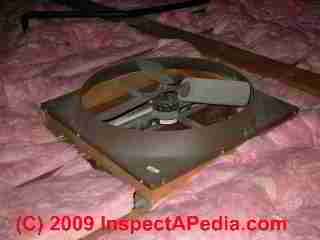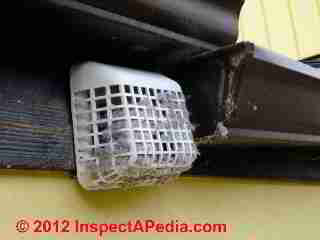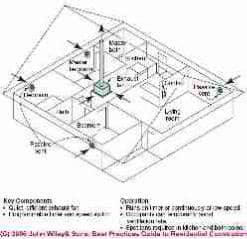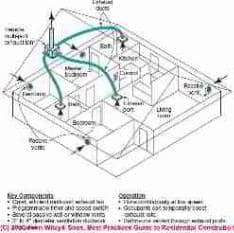 Exhaust Fan Ventilation System Guide
Exhaust Fan Ventilation System Guide
- POST a QUESTION or COMMENT about exhaust fan venting for buildings
How to diagnose & fix exhaust fan problems: this article explains using exhaust fan ventilation systems to improve indoor air quality in homes.
We include exhaust vent system troubleshooting checks: Here we provide air handler unit or blower assembly troubleshooting by expanded annotated information from the US EPA [5]who provided suggestions for investigating the air handling unit during an indoor air quality investigation.
InspectAPedia tolerates no conflicts of interest. We have no relationship with advertisers, products, or services discussed at this website.
- Daniel Friedman, Publisher/Editor/Author - See WHO ARE WE?
Troubleshooting Local Exhaust Vent Systems - Quick Checks

This article includes excerpts or adaptations from Best Practices Guide to Residential Construction (Steve Bliss, J Wiley & Sons) , by Steven Bliss, courtesy of Wiley & Sons. [Click to enlarge any image]
- Does the exhaust fan run? If not check for loose electrical connections or a blown fuse or tripped circuit breaker; the fan motor may also be damaged, or the fan itself jammed.
- Is the exhaust fan used when it should be? People often leave exhaust fans off when they should be run to remove unwanted odors or moisture, perhaps because the fan is too noisy.
See FAN NOISES
and Fan Noise Control - Does air flow out of the exhaust fan? If not check for a blocked fan duct or a dirty or clogged screen at the fan inlet or outlet. See examples of clogging
at Dryer Vent Covers - Is the quantity of air being exhausted sufficient to remove odors and unwanted moisture? If not, and presuming the fan ducting is correctly installed, routed, and clean, you may need a higher capacity fan. But first check that sufficient make-up air is able to enter the room where the fan is in use.
Exhaust-Only Ventilation for Improving Indoor Air Quality
As detailed in Best Practices Guide to Residential Construction (Steve Bliss, J Wiley & Sons) :
Exhaust-only ventilation is the most common approach, due to its simplicity and use of familiar components such as bathroom fans. However, unless houses are built very tight, there is little control over where fresh air enters the building.
Also, building depressurization can be a problem, particularly with high-capacity fans. In addition to the increased potential for backdrafting, a depressurized house tends to draw more soil gases, including radon if it is present. And in hot, humid climates, moist air infiltrating through exterior walls can condense on interior finishes such as the back face of vinyl wallpaper that is chilled by air conditioning.
Below we discuss three exaust-only ventilation approaches, followed by a discussion of Supply Only Ventilation
and
then VENTILATION, BALANCED.
Single-Port Exhaust House Venting Systems

The simplest and least expensive central ventilation system consists of an automatic timer wired to one centrally located bathroom or laundry fan so it cycles on and off for a portion of every hour or for the 8 to 12 hours per day when most people are home, typically mornings and evenings.
See the figure at left (click the image for details) about a single port exhaust house ventilation system.
The simplest ventilation system uses a single, centrally located exhaust fan that runs on a timer or continuously at a low speed. The fan may also serve as a bathroom or laundry fan, but a dedicated fan is optimal.
Passive air inlets are sometimes installed but will only work properly in very tight homes.
Illustration Source: Recommended Ventilation Strategies for Energy-Efficient Production Homes, 1998, by Judy A. Roberson, et al., Lawrence Berkeley National Laboratory, appearing in the text cited above.
Exhaust fan control switch: Since the house ventilation exhaust fan is doing double duty as a bath or laundry fan, it must have a manual override switch for intermittent use. In larger homes, two fans at separate locations can be used. Another upgrade is to use a dedicated fan in a central location, such as a hallway ceiling, which will provide better distribution of both exhaust and supply air.
Exhaust fan noise: For the house ventilation system to work well, it is important to use a quiet exhaust fan of one sone or less and choose a central location. Also, the door to the bathroom with the exhaust fan must be undercut by 3/4 to 1inch, along with doors to all 4 bedrooms and other rooms that require ventilation. An alternative is to connect the rooms with through-the-wall transfer grilles.
The biggest drawback to exhaust-only ventilation is that there is little control over distribution of the incoming air. Makeup air will come via the path of least resistance. In a leaky house, this might be a window or drop ceiling in the bathroom with the exhaust fan, leaving the rest of the house un served by the ventilation system. For this reason, single-port exhaust-only ventilation works well only in relatively small, tight houses.
- Passive air inlets. Some contractors install passive air
inlets in an effort to direct makeup air into bedrooms
and main living areas.
For these to work properly, however, the house must be extremely tight and doors must be left open or be cut at least an inch above the carpet. If a house is too leaky or rooms are cut off from household airflows, the inlets will function like other random holes in the building shell, leaking air inward or outward, depending on the wind, stack effect, and imbalances in the HVAC system.
The inlets typically require at least 10 Pascals of negative pressure to operate. They do not eliminate depressurization as sometimes thought. In fact, they require it to work properly.
Multiport Exhaust House Venting Systems

This type of system uses a more powerful exhaust fan that is remotely mounted, typically in the attic or basement. See the figure at left for details of a multi-port whole house exhaust fan vent system).
A multiport exhaust system improves air distribution by picking up air from bathrooms and main living areas. These are often used in conjunction with passive air inlets.
Exhaust-only systems are best used in homes with electric heating or sealed-combustion appliances where backdrafting is not a concern.
Illustration Source: Recommended Ventilation Strategies for Energy-Efficient Production Homes, 1998, by Judy A. Roberson, et al., Lawrence Berkeley National Laboratory, appearing in the text cited above.
The multiport house exhaust fan system is ducted to exhaust grilles in bathrooms, laundries, and other wet areas, and sometimes to a centrally located pickup point in the main living space. A room with no outside walls would also benefit from a pickup point.
Systems typically run on a low background speed with timer switches in bathrooms for higher-powered spot ventilation. If installed correctly, these systems are very quiet and provide good distribution of ventilation.
Multiport exhaust systems may incorporate passive air inlets (see description above) that install either in windows or through the wall, providing some control over supply air. The inlets, typically three or four for a small house, go in bedrooms, main living areas, and other occupied rooms, such as dens or home offices. Inlets should be placed high on the wall away from beds, chairs, or other places where drafts might cause discomfort. Placement near a window is preferred.
Because these systems use more powerful fans that depressurize the house, they should not be used in houses with fireplaces or atmospherically vented combustion appliances. They are also not recommended in hot climates, since hot, moist exterior air may be drawn into walls and condense behind interior surfaces chilled from air conditioning.
Packaged multiport house exhaust venting systems are available from American Aldes, Fantech, and a few other few manufacturers (see Resources, page 297 in Best Practices Guide to Residential Construction (Steve Bliss, J Wiley & Sons) )
Ventilating Heat-Pump Water Heater
This variation on exhaust-only ventilation passes the exhaust air through a heat-pump water heater, reclaiming heat from the outgoing air stream. Some systems can be reversed in summer, functioning as a supply ventilation system while cooling and dehumidifying the incoming air. A packaged heat-pump ventilating system is available from Therma-Stor.
-- Adapted with permission from Best Practices Guide to Residential Construction (Steve Bliss, J Wiley & Sons) .
...
Reader Comments, Questions & Answers About The Article Above
Below you will find questions and answers previously posted on this page at its page bottom reader comment box.
Reader Q&A - also see RECOMMENDED ARTICLES & FAQs
Question: connect a kitchen exhaust vent to an attic "vent pipe" ?
(June 3, 2011) bobby said:
Can u connect a kitchen exhaust fan pipe to a vent pipe in the attic to exhaust out?
Reply:
Kitchen exhaust vent routing:
Sure a kitchen vent fan can be routed via metal ductwork up through a building attic and out through a roof surface or out through a soffit. Of course the vent and routing need to be fire-safe, air tight (we don't want to blow grease into the attic nor feed a fire), and accessible for cleaning.
If you were asking if a kitchen exhaust fan can be connected to a plumbing vent pipe, the answer is no.
Question: how to dampen noise transmission from the exhaust vent
(Aug 30, 2011) Ed said:
I just installed a new range hood venting out to the roof. Problem is it is on an inside wall. Vibration noise comes through the wall into the other room, kitchen noise is normal for the range hood. Anything I can place behind the hood to lessen the vibration noise coming into the living room?
Reply:
Ed, you can use rubber or foam as a vibration dampener.
But
Watch out: for fire hazards: you will want to review the range hood and duct installation instructions to be sure that you are respecting any necessary fire safety clearances. You may be able to reduce those clearances by using fire proof materials or even fire-rated drywall.
...
Continue reading at VENTILATION, SUPPLY-ONLY or select a topic from the closely-related articles below, or see the complete ARTICLE INDEX.
Or see these
Recommended Articles
- VENTILATION in BUILDINGS - home
Suggested citation for this web page
VENTILATION, EXHAUST ONLY at InspectApedia.com - online encyclopedia of building & environmental inspection, testing, diagnosis, repair, & problem prevention advice.
Or see this
INDEX to RELATED ARTICLES: ARTICLE INDEX to BUILDING VENTILATION
Or use the SEARCH BOX found below to Ask a Question or Search InspectApedia
Ask a Question or Search InspectApedia
Try the search box just below, or if you prefer, post a question or comment in the Comments box below and we will respond promptly.
Search the InspectApedia website
Note: appearance of your Comment below may be delayed: if your comment contains an image, photograph, web link, or text that looks to the software as if it might be a web link, your posting will appear after it has been approved by a moderator. Apologies for the delay.
Only one image can be added per comment but you can post as many comments, and therefore images, as you like.
You will not receive a notification when a response to your question has been posted.
Please bookmark this page to make it easy for you to check back for our response.
IF above you see "Comment Form is loading comments..." then COMMENT BOX - countable.ca / bawkbox.com IS NOT WORKING.
In any case you are welcome to send an email directly to us at InspectApedia.com at editor@inspectApedia.com
We'll reply to you directly. Please help us help you by noting, in your email, the URL of the InspectApedia page where you wanted to comment.
Citations & References
In addition to any citations in the article above, a full list is available on request.
- Best Practices Guide to Residential Construction, by Steven Bliss. John Wiley & Sons, 2006. ISBN-10: 0471648361, ISBN-13: 978-0471648369, Hardcover: 320 pages, available from Amazon.com and also Wiley.com. See our book review of this publication.
- Energy Recover Ventilation Systems for buildings, U.S. Department of Energy
- Energy Savings Methods: Whole House Systems Approach, U.S. Department of Energy
- Natural Ventilation for buildings, U.S. Department of Energy
- [5] US EPA - Mold Remediation in Schools and Commercial Building [ copy on file as /sickhouse/EPA_Mold_Remediation_in_Schools.pdf ] - US EPA
- Spot Ventilation for houses, U.S. Department of Energy
- Slab on Grade Foundation Moisture and Air Leakage, U.S. Department of Energy
- Straw Bale Home Design, U.S. Department of Energy
- VAPOR BARRIERS or VAPOR DIFFUSION RETARDERS [PDF] U.S. DOE - how vapor barriers work, types of vapor diffusion barriers, installing vapor barrier
- VENTILATION for ENERGY-EFFICIENT BUILDINGS [PDF] Purpose of ventilation, ventilateion strategies, etc.
- Weather-Resistive Barriers, how to select and install housewrap and other types of weather resistive barriers, U.S. DOE
- Whole House Ventilation Systems, U.S. Department of Energy
- Whole-House Balanced Ventilation Systems, U.S. Department of Energy
- Whole-House Exhaust Ventilation Systems, U.S. Department of Energy
- Whole-House Supply Ventilation Systems, U.S. Department of Energy
- Our recommended books about building & mechanical systems design, inspection, problem diagnosis, and repair, and about indoor environment and IAQ testing, diagnosis, and cleanup are at the InspectAPedia Bookstore. Also see our Book Reviews - InspectAPedia.
- BASEMENT MOISTURE CONTROL [PDF] U.S. Department of Energy
- Building Pathology, Deterioration, Diagnostics, and Intervention, Samuel Y. Harris, P.E., AIA, Esq., ISBN 0-471-33172-4, John Wiley & Sons, 2001 [General building science-DF] ISBN-10: 0471331724 ISBN-13: 978-0471331728
- Building Pathology: Principles and Practice, David Watt, Wiley-Blackwell; 2 edition (March 7, 2008) ISBN-10: 1405161035 ISBN-13: 978-1405161039
- CRAWL SPACE MOISTURE CONTROL [PDF] U.S. Department of Energy
- LOG HOMES: MINIMIZING AIR LEAKAGE [PDF] U.S. Department of Energy
- Log Homes: Controlling Moisture in Log Homes, U.S. Department of Energy
- MOISTURE CONTROL in BUILDINGS [PDF] U.S. Department of Energy
- MOISTURE CONTROL in WALLS [PDF] U.S. Department of Energy
- Quality Standards for the Professional Remodeling Industry, National Association of Home Builders Remodelers Council, NAHB Research Foundation, 1987.
- Quality Standards for the Professional Remodeler, N.U. Ahmed, # Home Builder Pr (February 1991), ISBN-10: 0867183594, ISBN-13: 978-0867183597
- In addition to citations & references found in this article, see the research citations given at the end of the related articles found at our suggested
CONTINUE READING or RECOMMENDED ARTICLES.
- Carson, Dunlop & Associates Ltd., 120 Carlton Street Suite 407, Toronto ON M5A 4K2. Tel: (416) 964-9415 1-800-268-7070 Email: info@carsondunlop.com. Alan Carson is a past president of ASHI, the American Society of Home Inspectors.
Thanks to Alan Carson and Bob Dunlop, for permission for InspectAPedia to use text excerpts from The HOME REFERENCE BOOK - the Encyclopedia of Homes and to use illustrations from The ILLUSTRATED HOME .
Carson Dunlop Associates provides extensive home inspection education and report writing material. In gratitude we provide links to tsome Carson Dunlop Associates products and services.

